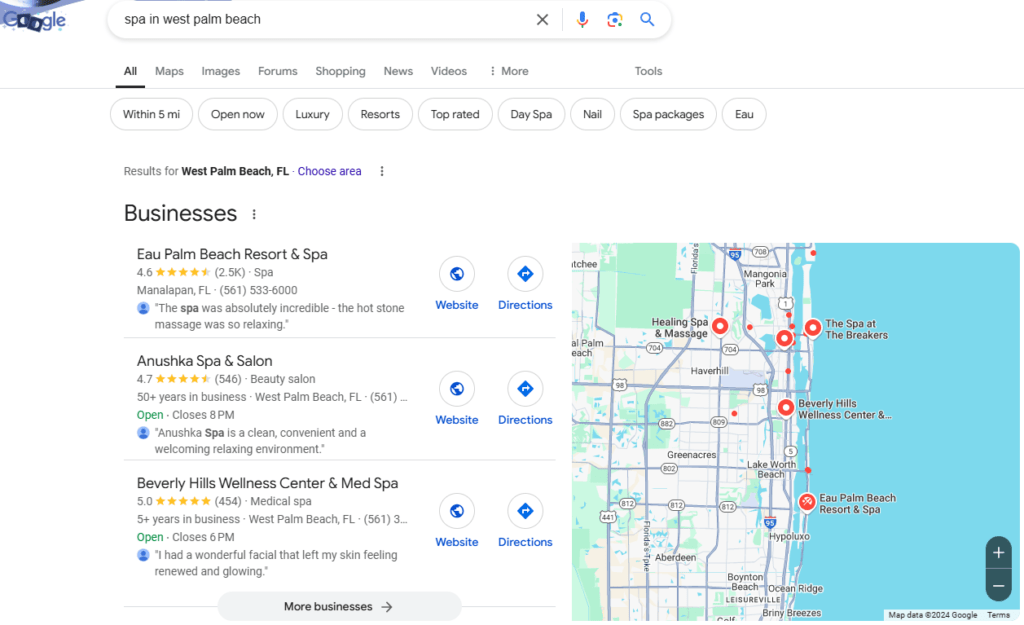Local search is a whole different beast compared to traditional SEO. Did you know that 46% of all Google searches have local intent? That’s huge! I’ve helped countless businesses climb those local search rankings. Whether you’re managing a single location or a multi-location business, understanding these 5 ranking factors is crucial for dominating your local market.

1. Google Business Profile Optimization
I’ve seen businesses invest thousands in fancy websites while completely neglecting their Google Business Profile (GBP). Big mistake! After managing hundreds of local SEO campaigns, I can confidently say that your GBP is the absolute cornerstone of local search success in 2024.
Let’s dive into what actually moves the needle for GBP optimization:
- NAP consistency: This one is non-negotiable. That’s Name, Address, and Phone number for those new to the game. I can’t tell you how many times I’ve seen businesses accidentally sabotage their rankings with inconsistent NAP information across their digital presence. Lack of consistency can impact your visibility.
- Business Categories: You get one primary category and up to nine secondary categories – use them wisely! I’ve seen businesses boost their local visibility by 40% just by optimizing their category selection. Pro tip: research your top-performing competitors’ categories. They’ve probably already done the testing for you!
- Regular Engagement: Think of your GBP like a mini social media platform. I recommend posting at least weekly – mix it up with special offers, business updates, and behind-the-scenes content. One of my clients in the restaurant industry saw a 52% increase in profile interactions after implementing a consistent posting schedule.
- Photos and Videos: These are very important, but they need to be high-quality and relevant. I’m talking about professional-grade images of your business, team, products, or services. This is also an area that needs regular updating, I recommend posting 3 to 5 new images per month and one new video per month if possible.
- Questions & Answers: Probably the most underutilized feature of GBP. Seed your own Q&A section with frequently asked questions. Not only does this help potential customers, but it also gives you control over the narrative and provides additional keyword opportunities. If you don’t answer questions, anyone else can and will, so ensure you monitor those questions that are being asked.
- Attributes: Google keeps adding new attributes to help businesses showcase their unique features and services. Whether it’s “women-owned,” “wheelchair accessible,” or “contactless payment accepted” – these attributes help you stand out in search results and can be the deciding factor for potential customers.
Remember, your GBP isn’t just a digital business card – it’s often the first impression you make on potential customers. In my experience, the businesses that treat their GBP as a dynamic marketing channel rather than a static listing are the ones that consistently outperform their competitors in local search.
Want to know if your GBP is actually performing? Keep a close eye on your insights tab. Track your profile views, website clicks, and direction requests. These metrics tell you if your optimization efforts are actually moving the needle. And trust me, with the right approach, they absolutely will.
2. Review Management and Reputation
Let me share something that might shock you: a business jumping from a 3-star to a 4-star rating typically sees a 25-40% increase in local search conversions. And here’s the kicker – Google’s local algorithm in 2024 isn’t just counting stars; it’s actually reading review content for semantic relevance.
Let’s talk about your review strategy:
- Review Generation: Timing is everything. You know when your customer is most likely to leave a positive review? It’s right after a moment of success or satisfaction. Train your staff to politely ask for reviews. You can also add some signage with a hashtag making it easier for them to provide a review.
- Responding to Reviews: You must respond to both positive and negative ones, all of them. Your responses aren’t really for the reviewer; they’re for every potential customer who reads them later. The key? Empathy first, solution second. And utilize the reviews to communicate what else you have to offer, other than what was reviewed, such as “Try our amazing skin rejuvenation treatment next time you’re here, our customers love it”.
Google’s algorithm is paying more attention than ever to how regularly you receive reviews. I’ve found that businesses with steady review velocity (2-3 new reviews per week) consistently outperform those with sporadic bursts of reviews.
Here’s something most people miss: review content optimization. Those keywords in your customer reviews? They’re pure gold for local SEO. I encourage my clients to be specific when asking for reviews: “Could you mention which specific service you received?” This naturally generates keyword-rich reviews without any manipulation.
How to Handle Negative Reviews:
Here’s the truth: a few negative reviews can actually help your credibility. In fact, profiles with 100% 5-star reviews can look suspicious to both Google and potential customers. What matters is how you handle them. I recommend a four-step formula for negative review responses:
- Acknowledge the issue with empathy
- Take responsibility (even if it wasn’t entirely your fault)
- Explain what you’re doing to prevent similar issues
- Invite offline conversation to resolve the matter
One final piece of advice: track your review metrics religiously. I’m not just talking about your overall rating – monitor your review response rate, average review length, keyword presence in reviews, and response time to negative reviews. These metrics form what I call your “review health score,” and it’s a crucial indicator of your local SEO performance.
3. On-Page Local SEO Elements
On-page local SEO isn’t just about stuffing city names into your content. It’s about creating a complete local relevancy story. If your business is local, that process if much simpler. If you have a business that caters to multiple locations or regions, you need to create local landing pages and ensure that story is told there. Sometimes that might mean creating multiple pages and creating a website within a website.
What is working in 2024 for local landing pages?
- Hyperlocal Content Anchors: These are specific references to local landmarks, events, and community features that tell Google, “Hey, we really know this area!”
- Title Tags and Meta Descriptions: They might seem basic, but I’m constantly amazed by how many businesses get them wrong. Here’s a proven formula for local title tags: Primary Service + City + Secondary Keyword | Brand Name. I recommend cutting the Brand Name if the Title Tag is too long, Google will re-write the Title in the SERP and it may not provide the best experience. For example: “Emergency Plumber in Seattle – 24/7 Service | Johnson Plumbing”
- Schema Markup: I can’t tell you how many times I’ve seen businesses implement basic LocalBusiness schema and call it a day. Big mistake! In 2024, you need to be using nested schema that tells a complete story about your business. Location-specific landing pages that incorporate local schema markup typically see a 35-40% increase in local search visibility compared to those without it.
- Mobile Experience: Stop reviewing your website on a desktop, you need to judge the usability and design through mobile. Not only does Google only crawl the mobile version of your website, but in the majority of industries, there is a higher percentage of users that view your website through a mobile device.
- Content Creation: Location-specific content creation is where most businesses fall flat. This is the approach I recommend:
- Start with local market research (what unique problems does this area face?)
- Include area-specific pricing if relevant
- Add local customer success stories
- Mention local regulations or requirements
- Reference local events or community involvement
- Start with local market research (what unique problems does this area face?)
- Internal Linking: Often overlooked, you need to take a local content hub approach. Imagine your main service page as the hub, with location-specific pages, blog posts about local projects, and community involvement pages all linking back to it. This creates a powerful local relevancy signal that Google loves.
- Keep Things Fresh: Your location pages should be some of your most valuable assets. They need regular updates, fresh content, and constant optimization. I recommend a quarterly audit of all location pages to ensure they’re still aligned with current local SEO best practices and the localized content is still relevant.
- Page Speed: People don’t want to wait for your website to load, especially when they are using a mobile device. I have even seen local rankings improve by simply reducing image sizes and implementing lazy loading on location pages.
Remember, successful local on-page SEO in 2024 is about creating a comprehensive local presence that serves both search engines and users. It’s not just about rankings – it’s about converting those local searchers into customers.
4. Citation Building and Management
Businesses with consistent NAP (Name, Address, Phone) information across at least 85% of their citations saw an average 23% improvement in local pack rankings. But here’s the kicker – it’s not just about quantity anymore. In 2024, citation quality and relevance matter more than ever.
What is moving the needle?
- Major platforms (Google Business Profile, Bing Places, Apple Maps)
- Industry-specific directories (think Healthgrades for doctors, Avvo for lawyers)
- Local directories (Chamber of Commerce, local business associations)
- General business directories (Yellow Pages, BBB, etc.)
Pro tip: Many businesses waste time and money building hundreds of citations on low-quality directories. I’ve found that focusing on about 40-50 high-quality citations yields better results than having 100+ mediocre ones. Quality over quantity is the name of the game in 2024.
How to manage all these citations:
- Audit existing citations using tools like BrightLocal or Moz Local
- Identify and correct inconsistencies, starting with the most authoritative directories
- Monitor for new citations and variations monthly
Here’s a lesser-known strategy that’s been working well: leveraging citation opportunities from local events and sponsorships. When you sponsor local events or join local business organizations, make sure to get listed on their websites. These local-relevant citations often carry more weight than generic directory listings.
Citation building and management in 2024 isn’t about playing the numbers game anymore. It’s about building a strategic, well-maintained network of business mentions that tell a consistent story about your brand across the web. Get this right, and you’ll create a strong foundation for your local SEO success.
5. Link Building for Local SEO
I’ve learned that local link building is an art form all its own. You need to create and leverage deep community connections. Locally relevant links from sites with lower domain authority often outperform high DA links from non-local sources.
How to build links through community engagement:
- Local events sponsorships
- Community fundraisers
- School programs
- Sports team sponsorships
- Local business partnerships
- Neighborhood initiatives
What is the commonality with the above recommendations? It is Brand Building. You might get some direct links from the above, but in the end, you want more people talking about your brand and knowing who you’re.
Google’s getting better at understanding context, so a link from a relevant local business page carries more weight than one from a generic links page. It’s about building a web of relevant, local connections that reinforce your business’s place in the community. When done right, these links not only help your SEO but also drive actual local customers to your business. And isn’t that what it’s all about?
These local search ranking factors continue to evolve, but they remain the foundation of a successful local SEO strategy. Remember, it’s not just about implementing these factors – it’s about doing them better than your competition. Start with your Google Business Profile and gradually work through each element, measuring and adjusting as you go. Don’t forget, all your marketing efforts will influence your visibility in local search because of brand awareness. Make sure you’re present where your customers are and that may include social media, local newspapers, local blogs, and other online and offline channels that will ensure your business is top of mind.
I’m an SEO and performance marketing leader who loves breaking down complex strategies into clear, actionable insights. I have driven growth for reputable brands such as SAP, Four Seasons, BioMarin Pharmaceutical, and Rosewood Hotels in SEO and Performance Marketing strategy.

